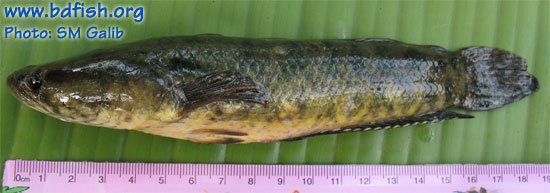
Systematic position (Nelson 2006)
Phylum: Chordata
Class: Actinopterygii (Ray-finned fishes)
Order: Perciformes (Perches)
Suborder: Channoidei (Ophiocephaliformes)
Family: Channidae (Snakeheads)
Genus: Channa
Species: C. punctata
Common/local names
English: Spotted snakehead
Bangladesh: Taki (টাকি), Lata (লাটা), Chaitan (ছাইতান) and Sati (শাটি)
India: Taki and Lata (West Bengal); Phool-dhok (Bihar); Duloora and Daula (Punjab); Soal (Jammu); Gorissa (Orissa); Matta-gudisa and Burada-matta (Andhra Pradesh); Korava-patti (Tamil Nadu); Kayichal and Arracan (Kerala); Korava, Kuchi and Belikkorava (Karnataka) (Talwar and Jhingran 1991).
Synonyms
Channa punctatus (Bloch, 1793)
Ophicephalus indicus McClelland, 1842
Ophicephalus karruwey Lacepède, 1801
Ophicephalus punctatus Bloch, 1793
Ophiocephalus affinis Günther, 1861
Ophiocephalus indicus McClelland, 1842
Ophiocephalus karrouveri Lacepède, 1801
Ophiocephalus lata Hamilton, 1822
Ophiocephalus punctatus Bloch, 1793
Distributions: Bangladesh, Afghanistan, India, Myanmar, Nepal, Pakistan, Sri Lanka and Yunnan (China) (Talwar and Jhingran 1991).
Conservation status: Not threatened in Bangladesh (IUCN Bangladesh 2000).
Morphology: Body elongate and cylindrical. Head 3.3-3.9 of TL and 2.7-3.3 of SL (Bhuiyan 1964). Eyes comparatively small and located anterior part of head. Eye diameter 6.2-8.5 of HL (Bhuiyan 1964). Lower jaw slightly protruding. No barbels. Scales large. Pectoral just above pelvic, caudal large and rounded. Pelvic is about 75% of pectoral fin length (Talwar and Jhingran 1991). 40-41 (Rahman 1989 and 2005); 37-40 (Talwar and Jhingran 1991; Shafi and Quddus 2001) scales on lateral line.
Body color varies with its habitats, generally yellowish to brown on back and lighter below. A series of about 8-9 vertical bands above lateral line, alternating with a similar series below it (Rahman 1989 and 2005). In some specimens, numerous black spots on body, dorsal fin, anal fin and caudal fin (Talwar and Jhingran 1991). Dorsal, anal and caudal fins are dark gray (Talwar and Jhingran 1991).
Fin formula:
D. 29-32; A. 21-23; P. 17; V. 6; C. 12 (Bhuiyan 1964; Shafi and Quddus 2001)
D. 29-32; P1. 15-18; P2. 6; A. 20-22 (Rahman 1989 and 2005)
D 28-33; A 20-23; P 15-18; V 6 (Talwar and Jhingran 1991)
Maximum lengths: 30 cm (Bhuiyan 1964; Shafi and Quddus 2001), 24 cm (Rahman 1989 and 2005) and 31 cm (Talwar and Jhingran 1991).
Habitats: Large freshwater ponds and tanks, generally in the plains (Talwar and Jhingran 1991). Found in ponds, ditches, beels and swamps of Bangladesh (Rahman 1989 and 2005). Also in oxbow lakes and rivers (Shafi and Quddus 2001).
Recorded from the Bookbhara baor in Jessore (Mohsin et al 2009), Chalan beel (Galib et al 2009a and 2010; Kostori et al 2011), Halti Beel (Imteazzaman and Galib 2013), Choto Jamuna River (Galib et al 2013), Padma river in Rajshahi (Samad et al 2010). Fairly common in Chilka lake of Orissa (Talwar and Jhingran 1991).
Food and feeding: Carnivore; voracious and predatory to small fish and fries (Bhuiyan 1964; Rahman 1989 and 2005). Feeds also on mollusks, insects (Shafi and Quddus 2001). Performs cannibalism (Shafi and Quddus 2001).
Spawning: Breeds once in a year, from April to June (Bhuiyan 1964); prolific breeder, breeds throughout the year (Talwar and Jhingran 1991). Lays floating eggs in a receptacle along the banks and guards its nest and fry (Bhuiyan 1964). Nests are semi-circular between marginal weeds, mature in first year and peak breeding before and during monsoon season (Talwar and Jhingran 1991). Both parents guard the fry up to 3-3.5 cm length (Shafi and Quddus 2001).
Accessory respiration: It has the accessory respiratory organ which is composed of a pair of incompletely bipartitioned air-chambers (Bhuiyan 1964), which is commonly known as accessory bronchial chamber (Hasan and Mohsin 2011). These chambers are located on each side of the auditory region of the skull (Bhuiyan 1964).
Fishery info: Of commercial importance (Rahman 1989 and 2005). Used as food fish in Bangladesh. Consumed fresh and sun-dried (Samad et al 2009).
Harvesting by hooks (Barshi, Dhan barshi and Jiana), traps (Polo and Kholsun) and various fishing nets was reported (Galib et al 2009b).
__________________________________________________________
REFERENCES
Bloch ME (1793) Naturgeschichte der ausländischen Fische. Berlin. Naturgeschichte der Ausländischen Fische. 7: i-xiv + 1-144, Pls. 325-360.
Günther A (1861) Catalogue of the fishes in the British Museum. Catalogue of the acanthopterygian fishes in the collection of the British Museum. 3. Gobiidae, Discoboli, Pediculati, Blenniidae, Labyrinthici, Mugilidae, Notacanthi. London. Catalogue of the fishes in the British Museum. 3: i-xxv + 1-586 + i-x.
Hamilton F (1822) An account of the fishes found in the river Ganges and its branches. Edinburgh & London. An account of the fishes found in the river Ganges and its branches.: i-vii + 1-405, Pls. 1-39.
Lacepède BGE (1801) Histoire naturelle des poissons. Histoire naturelle des poissons. 3: i-lxvi + 1-558, Pls. 1-34.
McClelland J (1842) On the fresh-water fishes collected by William Griffith, Esq., F.LS. Madras Medical Service, during his travels under the orders of the Supreme Government of India, from 1835 to 1842. Calcutta Journal of Natural History 2(8): 560-589.
Visited 13,606 times, 2 visits today | Have any fisheries relevant question?
